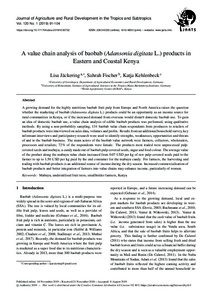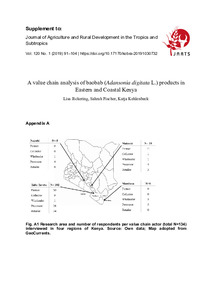| dc.date.accessioned | 2019-11-19T13:35:53Z | |
| dc.date.available | 2019-11-19T13:35:53Z | |
| dc.date.issued | 2019-11-14 | |
| dc.identifier | doi:10.17170/kobra-20191030732 | |
| dc.identifier.uri | http://hdl.handle.net/123456789/11357 | |
| dc.description | Gedruckte Ausg. im Verlag Kassel Univ. Press (www.upress.uni-kassel.de) erschienen. | ger |
| dc.language.iso | eng | eng |
| dc.rights | Urheberrechtlich geschützt | |
| dc.rights.uri | https://rightsstatements.org/page/InC/1.0/ | |
| dc.subject | Mabuyu | eng |
| dc.subject | underutilised fruit trees | eng |
| dc.subject | smallholder farmers | eng |
| dc.subject | Kenya | eng |
| dc.subject.ddc | 630 | |
| dc.title | A value chain analysis of baobab (Adansonia digitata L.) products in Eastern and Coastal Kenya | eng |
| dc.type | Aufsatz | |
| dcterms.abstract | A growing demand for the highly nutritious baobab fruit pulp from Europe and North America raises the question whether the marketing of baobab (Adansonia digitata L.) products could be an opportunity as an income source for rural communities in Kenya, or if the increased demand from overseas would disturb domestic baobab use. To gain an idea of domestic baobab use, a value chain analysis of edible baobab products was performed, using qualitative methods. By using a non-probability sampling, 134 baobab value chain respondents from producers to retailers of baobab products were interviewed on sales data, volumes and profits. Results from an additional household survey, key informant interviews and participatory research were used to identify strengths, weaknesses, opportunities and threats of and to the baobab business.
The main actors of the baobab value network were farmers, collectors, wholesalers, processors and retailers; 72% of the respondents were female. The products most traded were unprocessed pulp-covered seeds and mabuyu, a candy made out of baobab pulp-covered seeds, sugar and food colour. The average value of the product along the mabuyu value chain increased from 0.07 USD per kg of raw pulp-covered seeds paid to the farmer to up to 1.50 USD per kg paid by the end consumer for the mabuyu candy. For farmers, the harvesting and trading with baobab products is an additional source of income during the dry season.
Increased commercialisation of baobab products and better integration of farmers into value chains may enhance income, particularly of women. | eng |
| dcterms.accessRights | open access | |
| dcterms.creator | Jäckering, Lisa | |
| dcterms.creator | Fischer, Sahrah | |
| dcterms.creator | Kehlenbeck, Katja | |
| dc.type.version | publishedVersion | |
| dcterms.source.identifier | ISSN 2363-6033 | |
| dcterms.source.issue | No. 1 | |
| dcterms.source.journal | Journal of Agriculture and Rural Development in the Tropics and Subtropics (JARTS) | eng |
| dcterms.source.pageinfo | 91-104 | |
| dcterms.source.volume | Vol. 120 | |


